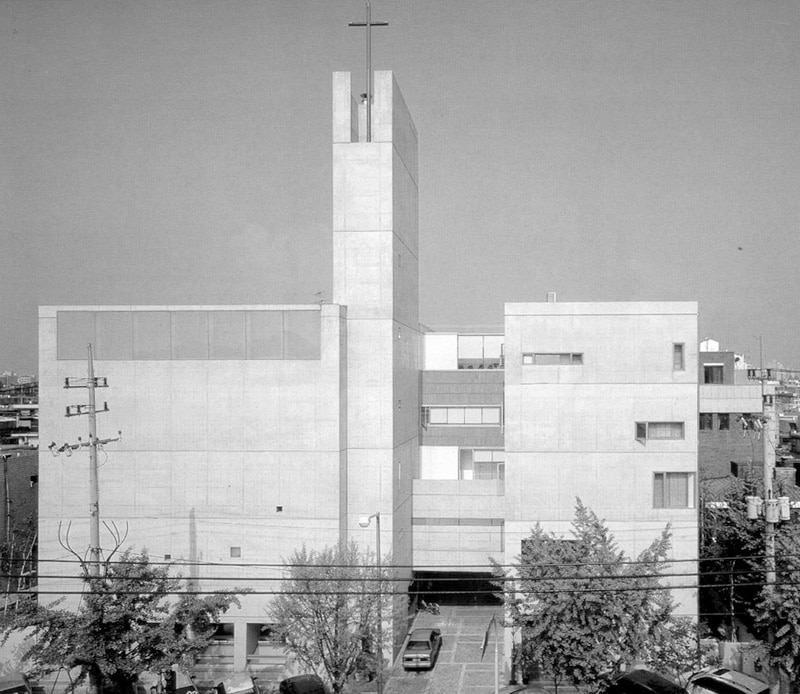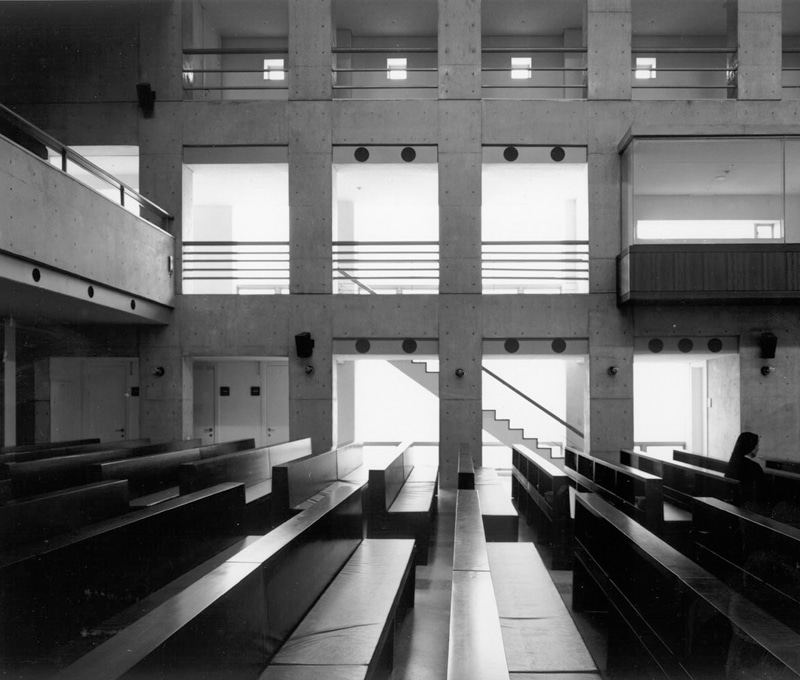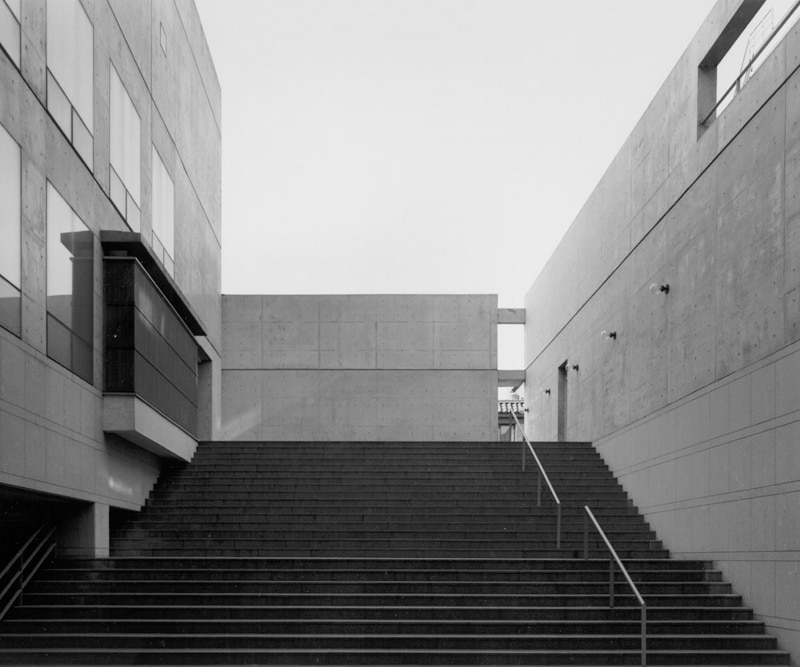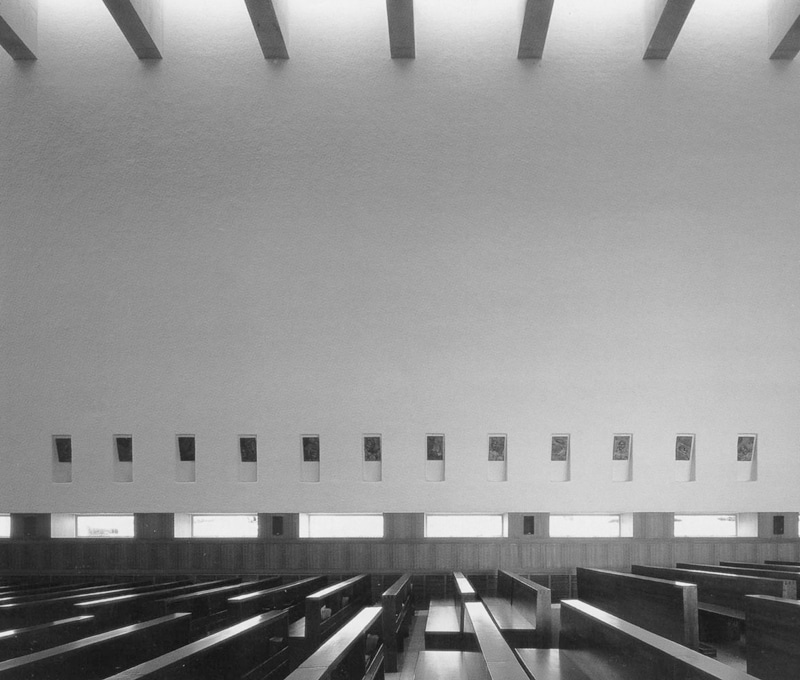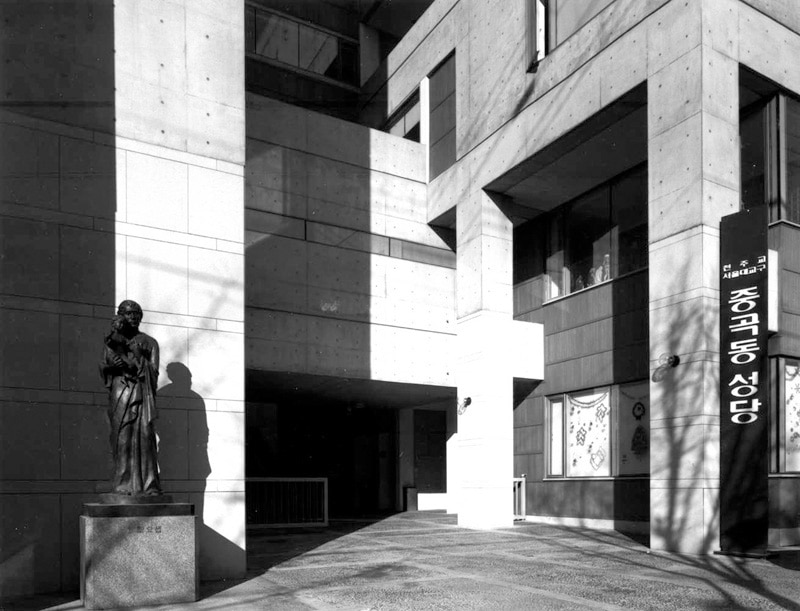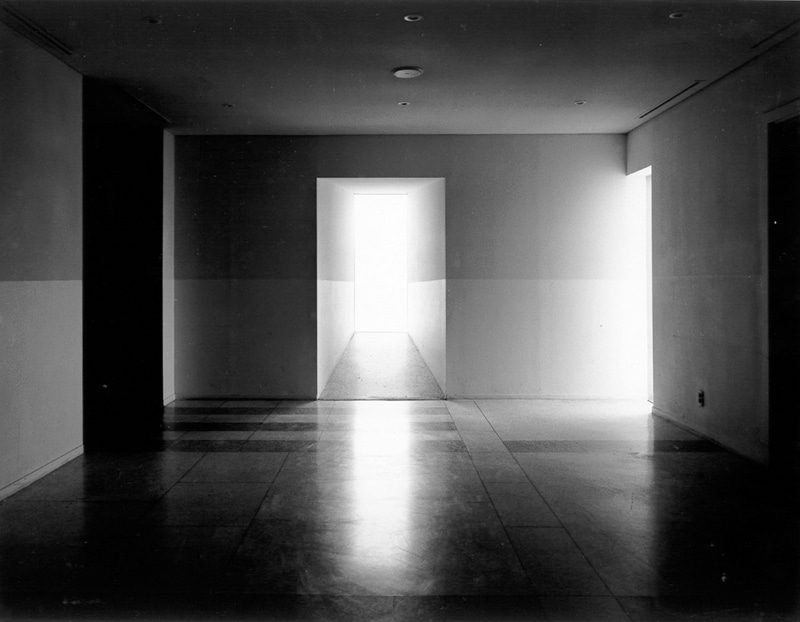Junggok-dong Catholic Church
| 완공년도 | 2001 |
| 위치 | 서울 중곡동 |
| 대지면적 | 1,806.1㎡ |
| 건축면적 | 1,058.6㎡ |
| 연면적 | 4,245.3㎡ |
| Structural engineer | 알트 구조 |
| Mechanical engineer | 세종 MEC |
| Electrical engineer | 명진 E&C |
| Contractor | 두산건설 |
| Scale | B2, 5F |
| 완공년도 | 2001 |
| 위치 | 서울 중곡동 |
| 대지면적 | 1,806.1㎡ |
| 건축면적 | 1,058.6㎡ |
| 연면적 | 4,245.3㎡ |
| Structural engineer | 알트 구조 |
| Mechanical engineer | 세종 MEC |
| Electrical engineer | 명진 E&C |
| Contractor | 두산건설 |
| Scale | B2, 5F |
1996년 6월부터 설계가 시작된 이 중곡동 성당은 우여곡절 끝에 2001년 초에 완공되었다. 옛날에야 성당을 짓는 일에 5년이라는 기간이 긴 기간이 결코 아니지만 요즘으로는 사뭇 길다. 이 기간은 또한 한 건축가의 사고 내용이 충분히 변할 수 있는 기간이어서, 5년이 경과한 후에 다시 돌아보게 되는 것이 낯 뜨거운 일이 아닐 수 없다. 더러는 기억할 수 없는 것도 있다. 마침 지난97년 모 건축월간지에 이 중공동성당의 설계진행과정을 필드노트라는 형식으로 생중계를 하겠다고 연재를 시작한 적이 있어 이를 토대로 설계 당시 가졌던 중요한 생각들을 소개하고자 한다. 이 생각의 편린들은 완공된 실제의 모습과 다른 것도 있으며 심지어는 지금 내가 가진 생각과도 다른 것도 있다. 그러나 이 생각들은 이 프로젝트를 위해 중요한 배경이었던 것은 틀림이 없다.
고딕과 종교적 건축
동 서양을 막론하고 건축의 역사 속에서 종교건축은 가장 중심적인 위치를 차지해 왔다. 자신의 삶과 죽음을 주관한다고 믿는 신에 대한 봉사 중에서 그 신을 모시는 건축을 만든다는 것은 참으로 감격스러운 것이며 더욱이 이 일은 선택 받은 자 아니고서는 할 수 없는 일이었다. 당연히도 최고의 건축가가 이 일을 위해 뽑혀졌으며 그 종교건축은 당대 최고의 지식과 기술이 동원되어야 하는 일이었고 최고의 예술적 성취가 이를 통해서 이루어져야 하는 성사였다. 서양건축의 변천사가 대체로 종교건축의 발달사임은 두 말할 나위가 없다.
역사적으로 가장 탁월한 종교건축의 성취는 물론 고딕양식이다, 거대한 높이의 벽과 가느다란 피어 사이에서 쏟아져 들어오는 빛과 그로 인한 교교한 음영이 만드는 경외롭고 신비한 고딕성당은 인간이 신에게 바치는 최고의 존경이었으며 이는 중량과 공간에 대한 건축가의 승리에서 비롯되었다. 미미한 인간이 지고의 신에게 바친 존경. 이렇게 이루어진 고딕은 그 이후 전 지역과 전 시대에 걸쳐 지어져 왔으며 인간의 존재가 더 이상 미미하지 않게 된 현대에서도 고딕은 교회의 상징이 되어 있다. 역량 있는 많은 현대의 건축가들이 만드는 종교건축 대부분이-그가 비록 정통적 고딕의 형태에서 벗어나 있다고 주장을 하더라도 결국은 고딕이 갖는 위엄과 신성의 범주 안에 있으며 또한 대다수의 교인과 성직자들도 그것이 자연스러운 형식임을 믿는다. 오히려 고딕의 뾰족탑에서 신성이 비롯되는 듯한 가치 전도가 더욱 많은 지지를 얻고 있기도 하다. 내가 믿기로는 이는 종교-특히 기독교나 천주교의 본질에서 크게 벗어나 있는 것이다. 따라서 이것은 그들이 말하는 ‘종교건축’ 일 지는 몰라도 종교의 본질에 접근하는 ‘종교적 건축’ 은 아닐 수 있다.
이는 내가 종교건축을 대하면서 대립해야 하는 많은 과제 중에서 첫 번째의 것이다.
샤먼의 종교
우리나라 사람들은 어쩐지 다른 나라 사람들 보다 종교적이다. 어디에도 신이 있다고 믿고 있으며 생사화복의 근원이 그 신에서 비롯된다고 철두철미 믿는 백성들이다. 하늘에도 산에도 땅에도 바다에도 나무에도 돌에도 집에도 심지어는 방 마다에도 다른 신들이 있다고 믿는다. 태어나서부터 죽을 때까지 그리고 죽은 후에도 온갖 일상사를 무신의 주도 아래 그 길흉을 조작 시키기를 원해 온, 샤머니즘의 지독한 영향 속에 가두어진 민족이다. 전래되었으나 우리의 전통 문화에 절대적 영향을 미친 불교나 현재 전세계에서 가장 큰 위세를 떨치는 한국의 기독교도 이 땅에 들어와서 미상불 이 땅에 가득 찬 샤머니즘과 결합되어 있을 것이다. 물론 전교를 가장 큰 사명 중의 하나로 하는 종교의 목적 상 그 지역에서의 토착화를 위해 어느 정도 그 지역의 특수 사정과 타협하여야 할 것이다. 그러나 그 타협이 그 종교의 본질을 넘나들 때 우리는 이를 사이비라 하며 이는 이미 타락한 종교이다. 이 타락한 종교는 그의 정통성을 강변하기 위해서 온갖 증거를 조작하려 하며 이 조작된 증거를 상징화하려 한다.
상징과 부호에 몰두하는 종교는 눈으로 확인하고 손으로 만져야만 믿게 되는 종교이다. 이런 종교는 결국은 육체의 안위와 일신의 영달에 더 큰 관심을 가지게 되고 이는 해탈이나 구원 나아가 자비나 사랑의 실천 같은 종교의 본질적 요소를 흐리게 한다. 그렇다. 내가 그려야 하는 건축이 샤먼의 건축이 아닌 이상 종교 건축에서의 상징과 부호 또한 내가 극복해야 하는 중요한 건축 과제이다.
지역 공동체, 신앙 공동체로서의 성당
중곡동 성당은 도시 내에 있는 성당이다. 순교지를 기리는 기념성당이 아니며 성사를 기념하는 순례자의 성당도 아니다. 말하자면 평범한 도시 성당이며 따라서 지역과 긴밀한 관계를 가져야 하는 지역적 종교 공동체이다. 지역의 종교 공동체로서의 건축 공간은 전례를 위한 내부공간인 대성당 외에 분과활동을 위한 대소 교리실을 위시하여 관혼상제나 여러 이벤트, 혹은 교우 상호간의 교류를 위한 공간 등 다양한 종교 활동을 위한 장치가 필요하다.
그러나 대부분의 성당건축은 이들을 내부의 층 별로 적당히 배분하고 소요되는 크기를 칸막이로 구획하여 배분하는 형식을 취할 뿐이다. 마치 신은 본당 내부에만 있고 이런 곳에는 임재하지 못하는 듯 비종교적 건축의 모습이 대부분이다. 그러나 지역민들의 부족한 문화적 공간으로 그 성당이 전용된다 하여도 그 지역민들이 성당의 경내로 내딛는 순간 그 영역은 이미 경건의 장소이며 은총과 신비로 가득 찬 축복된 장소임을 확인시킬 수 있어야 한다. 가능하다면 기둥과 벽체 하나에도 이 종교가 가리키는 의미를 담아 낼 수 있어야 할 것이다. 이는 또한 중요한 명제였다.
‘부르심의 기적과 응답의 은총’
내가 그렸던 초기안은 본당을 지하에 두고 길다란 경사로를 통하여 접근하게 한 것이다. 경사된 본당의 지붕은 지면을 뚫고 솟아 도로로부터 직접 연결되어 성당의 중심공간이 되도록 하였다. 이 경사진 외부공간은 때로는 옥외 성당으로 혹은 다양한 공연과 행사를 가능하게 하도록 적절한 크기와 경사를 가지고 있었고 그 위를 사제관과 수녀원, 교리실이 둘러싼다.
나의 지하 성당 안을 관찰한 성당 건축위원회의 의견은 엇갈린 모양이었다. 기존의 관습을 좇아 만든 성당과 새로운 실험을 놓고 오랜 시간 논의를 거쳤다. 아무튼 나는 선택되었고 몇 가지 새로운 지침의 수용을 요구하였다. 그러나 그 후 나는 이 설계안을 스스로 바꾼다. 전체 규모를 축소해야 하는 문제도 기존안의 볼륨은 유지하지 못하게 하는 것이었지만 내가 나의 개념을 위해 만든 모든 장치들이 그 작위성을 노골적으로 들어내는 듯 보이는 게 꺼림직하게 작용하고 있던 것이다. 더구나 가장 중요하게 생각된 곳이 축복의 햇살이 가득 내리는 듯한 교회 마당의 정경이었다. 이는 내가 어릴 적부터 잊지 못하는 추억의 한 부분이기도 한데 이를 만들 수가 없어 지상으로 다시 본당이 나오게 된다. .
넓지 않은 마당을 유용하게 쓰려면 모든 동선이 이 곳에서 모여지고 흩어져야 한다. 따라서 사무실이나 만남의 방 등 많은 동선이 모이는 기능을 이 마당과 같은 레벨에 두고 본당을 들어 올리면 하는 수 없이 교리실 등의 시설들은 지하에 위치하는 기존의 성당을 답습할 도리 밖에 없다. 여전히 남는 문제는 이 교리실의 통풍과 채광의 조건이다.
그러나 본당에 접근하기 위한 데크와 마당의 공간은 이 가운데 외부 공간을 드라마틱하게 조우하게 한다. 만남의 방과 데크 사이의 3m 폭의 갤러리 공간을 통하여 마당으로 연결되는 뒷 도로에서의 접근은 이 성당이 이 도시 속에 견고히 세팅되기 위한 필수적 장치이다.
언젠가 명동성당의 한 주교가 이야기한 단어의 배열을 잊을 수 없다, 그 분은 성당을 ‘부르심의 기적과 응답의 은총’이 가득한 거룩한 장소라 했다. 부르심의 기적과 응답의 은총. 되뇌일수록 참 아름다운 말이 아닌가.
성소
본당은 길다란 직사각의 평면이다. ‘화해’가 전례의 중요한 목표가 되는 본당의 평면 형식은 현대에 접근하면서 다양한 형태가 시도되어 경우에 따라 공동체의 따뜻한 분위기를 만드는 데 성공한 사례가 많이 있으나 회중의 숫자가 많아 지면 원형이나 방사의 평면은 아레나나 공연장처럼 될 위험이 있다. 이러한 공간에서 신성의 획득은 도달하기 어려운 문제이며 주변 환경이 어수선한 까닭에 더욱 긴장된 공간을 대두 시킬 필요가 있었다. 원래의 설계에서는 솟아오른 제단 뒷벽 3m이상은 빛이 쏟아지는 유리벽이었다. 길다란 경사로로 지하로 진입하여 어두운 전실을 지나 본당의 문을 열고 본당 내부로 들어 간 순간 정면에서 쏟는 밝은 빛은 처음 찾아 온 이들에게는 확연히 구분된 성소 공간의 인식을, 다시 찾는 이에게는 그 구별된 공간에 대한 그리움을 부를 것으로 기대하였으나 제단의 활동이 더욱 잘 보여지기를 원하는 건축위원회의 강력한 권고를 받아 유리벽을 막지 않을 수 없었던 것은 아직도 아쉬운 부분으로 남아 있다.
그러나 아무 장식이 없는 벽체는 여전히 많은 이들에게 생경스럽다. 이것은 일상적이 아니다. 이 당황스럽기까지 한 이 벽체에 신도들의 시선이 도달하여 오랫동안 쌓이면 그 자체가 귀한 성소가 될 것을 믿는다.
우리가 믿는 모든 것으로부터의 자유
얼마 전, 성당건축도 신부 중에서 몇 명을 선발하여 전문적 건축훈련을 시킨 다음 성당건축을 전담시키는 방법이 카톨릭 교계 내에서 거론된다는 것을 알게 되었다. 과거에도 건축에 탁월한 재능이 있는 신부가 성당건축을 담당한 예가 있었다. 또한 그런 신부들이 설계하고 공사 감독한 몇몇의 성당들이 괄목할 만한 좋은 건축이었던 관계로 내부에서 발탁하여 쓰는 ‘건축 신부’ 의 효용성이 자못 설득력 있게 받아 들여질 수 있다. 그러나 이 논의는 참으로 위험하다. 그렇지 않아도 시대착오적 건축을 양산하는 불교건축의 반문화적 건축부재의 현상을, 한국의 현대건축의 성장에 중요한 역할을 담당한 카톨릭마저 답습하기 시작할 수 있다. 아마도 꼭 그렇게 될 것이 불 보듯 뻔하다. 물론 이런 논의의 배경은 전례가 중심이 되는 성당의 건축은 전례를 가장 잘 이해하는 신부가 건축훈련만 받으면 가장 잘 건축할 수 있다는 것이며 이를 잘 알지 못하는 일반 건축가가 잘못 설계하여 초래되는 낭비와 폐단을 없애자는 것이다.
그러나 그렇게만 이해하기에는 건축은 너무나 복합적이며 포괄적 문제이다, 물론 신부도 좋은 성당을 설계할 수 있다. 만약에 어떤 신부가 그야말로 참 좋은 성당을 설계하고 지었다면-건축의 본질적 측면에서도-그 신부는 신부 이전에 독립적인 의견을 가진 건축가이며, 그가 바른 건축가라면 그의 의견이 전체를 지배하여서는 안되는 것도 아는 지성인일 것이다. 지성인. 그렇다. 건축가는 풍부한 감수성을 가지고 보편적 세계를 바라보는 지성인이라고 한다.
지성인이란 누구인가. 오리엔탈리즘의 저자 에드워드 사이드에 따르면 지성인은 ‘애국적 민족주의와 집단적 사고, 그리고 계급, 인종, 성적인 특권의식에 의문을 제기하는 사람들’ 이며, 보편성은 ‘일상적으로 다른 사람들의 실체로부터 우리를 보호해 주는 것들인 출신배경, 언어, 민족성으로부터 비롯되는 안이한 확신들을 초월하기 위한 위험을 감내해야 한다는 것을 의미한다.’ 는 것이다. 그리고 보편성은 또한 ‘대외정책이나 사회정책과 같은 문제에 직면해서도, 인간 행동의 단일 표준을 찾고 유지하려는 것’을 의미한다고 그는 덧붙여 정의한다. 만약 우리가 사이드의 이 정곡을 찌르는 지성인의 견해에 동의한다면 건축은 그 건축을 탄생시키는 모든 요인으로부터 자유로울 수 있는 건축가가 그 건축을 담당하는 것이 훨씬 올바르며 그러함으로 그는 그 본질적 건축에 더욱 접근할 수 있을 것이다.
나는 이러한 이유로 어떤 분야에 전문적인 건축가가 따로 존재한다고 믿지 않으며, 그런 이들이 만든 그런 전문적 건축이 보편적 삶을 사는 뭇 대중에게 좋은 삶 터가 될 가능성이 별 없어 보인다. 성당 전문 건축가, 병원 전문 건축가, 주택 전문 건축가, 그들은 성당과 병원과 주택을 알지는 몰라도 건축을 아는 것과는 별개의 문제이며 오히려 그러한 전문적지식과 견해가 건축이 기본적으로 해결해야 하는 ‘삶의 터’ 라는 명제를 간과할 위험이 가득하다. 나는 어떤 프로젝트를 착수하면서 항상 먼저 풀어야 하는 숙제가 내가 가지고 있는 그 프로젝트류 건축 속에서의 경험과 그로 인한 선입관념에 대한 검증이다. 무엇보다도 그러한 검증과 의심에서 보다 본질적인 문제에 도달할 수 있었으며 그것이 그 프로젝트의 가장 중요한 실마리가 되는 예가 허다해 왔다.
20년 전인 지난 1977년 마산성당의 설계로 김수근 선생과 요셉 프랏츠 신부가 처음 만날 때의 일을 기억한다. 오스트리아의 그라쯔 교구에서 재정을 지원하여 짓게 된 마산성당의 설계를 의뢰하는 이 신부에게 김수근 선생은 자신은 크리스천이 아님을 처음에 전했다. 소박한 성당이 되기를 원한다는 신부는 그러함으로 기존의 성당과 다른 장소를 만들 수 있음을 얘기하며 서로 좋은 성당을 만들기로 다짐하는 것을 지켜 보았다. 그 후 선생으로부터 내가 듣는 질문은 ‘종교가 무엇이냐’, ‘카톨릭이 무엇이냐’ 라는 것이 대부분이었다. 태어날 때부터 개신교도였으며 고등학교 때 까지를 교회와 더불어 생활했던 그래서 종교에 대해서는 스스로 그 지식이 적지 않다고 여겼던 나였음에도, 선생의 그 본질적 질문에 대답할 수 없었다. 나는 선생이 짐작하는 종교의 본질에 도달하는 건축을 그리기 까지 내가 알던 종교생활을 조목조목 되씹어 따져야 했고 내가 가진 잘못된 생각의 틀을 고치려 무진 애를 써야 했다. 그것은 내가 처음으로 받은 건축가로서의 참된 교육이었으며, 그 이후로부터 지금까지 결코 잊혀질 수 없는 교훈이 되었음은 물론이다.
우리가 믿고 있는 모든 것으로부터 자유로워 지는 것, 이것이 우리가 좀더 건축을 중심에서 지켜볼 수 있는 방법일 것이며 그 결과 참 좋은 건축을 그릴 수 있음이다.
Began designing in June 1996, Junggok-dong Catholic Church took five years to complete by early 2001. Compared to the Middle Ages, it is a short period, but it is quite a stretch in this age of fast life. The period is substantial enough to change the conceptual philosophies of an architect, and it is humbling to look back on former ideas, some of which one tends to forget after a while. However, in 1997 I started a series of features called ‘field notes’ on the project in an architectural magazine, which left me with traces of the thoughts behind the project. Some of these fragmented discourses differ from the finished work, and some even differ from what I believe now. Nevertheless, they were important clues to the framework for the project. Here are some excerpts.
Gothic and religious architecture
Regardless of region, religious architecture has been in the central position throughout the history of architecture. It is a blessed event to build a structure for a god for one who believes in the god being a powerful figure who oversees their life and death. The function was only for a chosen one. Only the best architects were chosen for this purpose, and the process required the most advanced technology and knowledge, culminating in the finest cultural accomplishment. It is well known that the current division of architectural styles was based on the development of religious architecture.
The most renowned religious architectural style is, of course, Gothic. The mystical and wondrous gothic church, with massive, high walls and delicate shadows created by the light infiltrating through thin piers, was the utmost respect paid to God by mankind, and it was a victory of architects over gravity and limited space. The greatest reverence to God by mere humans, the style continues to be the symbol of the church in a modern age when the human race has achieved a name for itself. No matter how contemporary architects claim their religious buildings to be far apart from the Gothic style and how different the architecture looks on the surface, the buildings are within the norm of majesty and divinity set by the Gothic example. It is the ideal religious architecture considered by most clergies and believers. Instead, some think the divinity seems to reside in the high-pointed towers of Gothic architecture. But I believe this is far from the teachings of Catholics and Protestants. Gothic style might be what they call a ‘religious building,’ but it stands far from a ‘religious architecture’ that addresses the essence of the religion.
This is the first task I have to face in realizing the religious architecture of today.
Shamanism
Our people have been inclined to be religious. We believe gods reside everywhere, and we consider these gods to be the fountain of our fate. Gods reside in heaven, mountains, fields, seas, and trees, in mere stones, houses, and even in each room. Our lives have been heavily guided by a shamanistic belief that deals with every matter from our birth to our afterlife. Buddhism, which was implanted a thousand years ago, and even our ‘recent’ imported Christianity, have been fused with our traditions, whether be it superficial or subconscious. The distinct purpose of religions to propagate might have played a role in adapting itself to local conditions. But, if this comprises becomes greater than a certain portion to affect the core of the religion, we call such a fraud, and it is no longer a religion worth existing. But more prevalent in this sham is the manipulated evidence of authenticity and endeavor to symbolize.
A religion that covets icons and symbols relies more on visual and tactile proof. More often than not, this kind of indecent religion leads people to have more concern for this life, which in turn obscures the essence of sacrifice, deliverance, and salvation. Since I do not pursue architecture of shamanism, symbols and icons are the only obstacles to overcome to reach an ideal religious architecture.
Regional community; Church as a religious community
Junggok-dong Catholic Church is a building within an urban context. It is not a place for pilgrimage nor a church for commemoration. It is an ordinary urban church, which implies that it has to be tied to the religious community. This endows the church with various other functions added to the mass hall, which include space for education, gathering community members, and ceremonies such as weddings and funerals.
The usual method of separating these functions was to build a series of slabs with partitions dividing the area into mere segments as if God was explicitly kept at the mass hall. Everything else was disconnected from the sanctuary. However, no matter how many functions the church has to carry, if one has stepped onto the grounds, one is already within a place of piety, and it has to be shown that the space is filled with grace and mystery. Even a mere pillar or a partitioned wall should convey that. This is another object that I see among many.
The miracle of calling and grace of answering
The initial scheme I came up with was to set a long ramp to the underground mass hall. The inclined roof of the mass hall would break out from the ground and connect to the street to form the central space of the church. The inclined outdoor space had the right size and angle to admit various ceremonies and activities. The rectory, nunnery, and classrooms for religious doctrine enclose this space from above.
Opinions among the architectural committee of the organization differed. They reviewed my ‘experimental’ scheme several times, sometimes comparing it to a ‘traditional scheme.’ In the end, they selected my scheme and asked for revisions. Eventually, I was forced to turn the whole scheme upside down. There were problems with reducing the entire mass and scale, but mainly because of my uneasiness with all the apparatus I had set up to convey my concept, which seemed to show too much artificiality. Moreover, the scheme did not satisfy my image of a church’s courtyard filled with sunlight that had been engraved into my memory from early childhood. So, the mass hall emerged from the ground to stand firm on the site.
To use the ‘madang'(courtyard) sparingly, every movement had to be converted into it to be distributed again. Therefore, office and meeting rooms had to be on the same level, pushing the mass hall to the upper level and leaving the classrooms underground. Solving the lighting and ventilation condition of these rooms was critical.
Madang and the deck to the mass hall meet outside quite dramatically. The 3-meter-wide gallery space between the decks and meeting room knits the madang to the street behind, which is vital for setting the building into the urban context.
Words from a bishop I heard some time ago still echo in my mind. He defined the church as a holy place for ‘the miracle of calling and the grace of answering.’ It was a phrase that I kept during my involvement with this project.
Sacred Place
The mass hall is in the shape of a slender rectangle. The mass hall’s formation in the contemporary age has undergone various transformations to achieve the best resolution during the ceremony. There are many successes. However, when the size of the congregation increases, the circular or radiating typefaces the problem of typologically closing into an arena or theater. This phenomenon is not desirable for a space of worship. Since the surrounding context was muddled in this particular area, it was crucial to inject intensity and tension into the space. Initially, the wall behind the altar from 3 meters up was to be made of glass that should let light in to fill the space. After a long trail through the ramp to underground, through a dark vestibule, one would enter to find a splashing light that reveals the sacred, something to recall the space. But the committee was worried that the light might interfere with the ceremony on the altar and thus recommended blocking the wall. I still wonder what it might have been like if it had remained.
The bare walls that enclose the space would be unfamiliar. This is not normal. Some might even be confused by this gesture. However, the wall would become an essential part of the space long after the accumulation of incongruous stares from the congregation.
To be Free from everything we know and believe in
Recently, I learned that within the Catholic community, there had been some discussion about selecting a number of priests to be trained in architecture to design catholic churches. There have been cases in history where a remarkable cleric was in charge. And, since some examples where clergy designed and supervised the construction ended with conspicuous buildings, promoting a ‘priest architect’ might sound persuasive. This is a dangerous notion. We have already seen the anti-cultural activities prevalent in Buddhist architecture, holding onto a bygone era’s style: an architectural vacuum. Catholicism, one of the important patrons in the development of Korean architecture, might follow a path to doom. There can be no doubt.
Of course, these discussions arose because there was an assumption that, for a religious building requiring intimate knowledge of ceremonies, a priest with a profound understanding of such could design it better than an ordinary architect who would make mistakes.
However, practicing architecture in such a limited way is not practical or desirable. Architecture is too complex and inclusive. Of course, a man with a calling could design a better church. But, if such a priest did design a great catholic church, it is only because he was an architect with his independent decisions, understanding, and listening to other opinions before he became a man of God. Yes, he is an intellectual. One refers to architects as intellectuals that see the world objectively with great susceptibility.
Who are intellectuals? According to Edward Said, author of Orientalism, they are the people who ‘raise questions to nationalism, collectivism, and prerogatives of class, race, gender.’ Objectivity, he continues, means ‘enduring the risk to overcome the safeguard of our background, language, and nationality’, ‘faced with social issues, objectivity tries to find a single standard and tries to uphold it.’ If we agree with his definition of the intellectual, architecture should be dealt with by an architect who is free from all the issues contained within, which will enhance the chance to be close to the essence.
Therefore, I do not believe that a specialized architect exists for specific functions, nor would there be a possibility to provide a life ground for ordinary people through this specialization. There might exist architects for churches, architects for hospitals, and architects for housing. They would know about the functions they are responsible for, but it would be different from knowing architecture. Rather the specialized knowledge would be in the way of realizing the basic understanding of the place of life.
I am cautious when engaging in a project with which I have much experience. It is vital to verify the existing notions within the same field and to inspect what I know beforehand. Through this investigation, I have reached conclusions I could never have otherwise, and more often than not, it gave me clues to the new project.
Even 20 years after, I remember vividly a meeting between my mentor, architect Kim Swoogeun, and Father Joseph Platzer. The meeting was about Masan Cathedral. Funded by Graz parish Austria, my mentor confessed he was not a Christian when Father Platzer entrusted the project to Kim Swoogeun. Father Platzer answered that it was an opportunity to build a cathedral that was to be different because of this. Since the interview, Kim repeatedly asked me what religion and Catholicism were in this world. Born a Protestant, raised with a bible through high school, I regarded myself as an expert in religion, only to murmur to a simple fundamental question. I had to reexamine every notion I had up to that point and investigate my thought process. This was the first essential teaching I had received as an architect. It has remained with me since.
To be free from everything we know and believe in would be the step to perceive architecture from within without losing our connections to the world around us. I can only pray after that.
